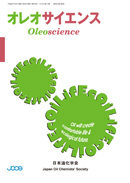
- |<
- <
- 1
- >
- >|
-
Toshio INAGI2020Volume 20Issue 12 Pages 535-541
Published: 2020
Released on J-STAGE: December 04, 2020
JOURNAL FREE ACCESSSilk in Japan became the world's largest production of raw silk in the Meiji era, making it a foot starting point for Japan's modernization. After that, the sericulture industry grew into Japan's core industry after World War II, although there were some changes. However, since the 1965's, the silk industry centered on clothing has receded due to the import of cheap raw silk overseas, the spread of chemical fibers, and changes in the supply and demand structure. However, silk is not only fibers, cosmetics using UV shielding effect, medical devices such as biological electrodes, further approaches from a new viewpoint, such as pharmaceuticals that apply genetic recommissioning has attracted attention. In this paper, we outline the history of silk and the future image of silk as seen from new research trends.
View full abstractDownload PDF (1411K) -
Hidetoshi TERAMOTO2020Volume 20Issue 12 Pages 543-548
Published: 2020
Released on J-STAGE: December 04, 2020
JOURNAL FREE ACCESSHerein, we have introduced two novel silk materials, developed using unique silkworm varieties. A silkworm variety, “Sericin Hope” was reared using conventional breeding techniques. Sericin Hope produces thin cocoons made exclusively of sericin, a family of hydrophilic glue-like silk proteins. Native sericin is easily extracted from these cocoons, and can be used to create self-standing pure protein materials, such as films and hydrogels. These materials can be used in cosmetics, cell culture, and tissue regeneration. Transgenic techniques were used to generate novel silkworm varieties with unique characteristics, which cannot be produced by conventional breeding. The ability to use synthetic amino acids during protein biosynthesis was endowed upon silkworms, using a transgenic technique. Consequently, an azido-bearing synthetic amino acid, 4-azidophenylalanine (AzPhe) was successfully incorporated during protein synthesis, to produce AzPhe-incorporated silk fibroin. Azido groups in the AzPhe-incorporated silk fibroin or “clickable silk” can be selectively modified by click reactions. Cell culture substrates, whose cell adhesive properties can be controlled by light, were developed using clickable silk. Spatial patterning of mouse fibroblasts was achieved using this technique.
View full abstractDownload PDF (1081K) -
Yasumoto NAKAZAWA, Ayane YAMAMOTO2020Volume 20Issue 12 Pages 549-556
Published: 2020
Released on J-STAGE: December 04, 2020
JOURNAL FREE ACCESSIn regenerative medicine, not only cells and growth factors for regenerating tissues and organs are indispensable, but also tissue engineering materials as a scaffold for cells to reconstruct tissues. The biocompatibility of tissue engineering materials, including immunotoxicity, blood compatibility, tissue compatibility, physical properties, degradability, and inflammatory properties, needs to be optimized according to the transplant site. Various tissue engineering materials able to fulfill these requirements have been reported recently, with silk fibroin being a great candidate.
Silk fibroin is a fiber protein produced by silkworms, and although it is usually collected as a thread, its form can be changed by various molding processes, resulting in films, sponges, nanofibers, and gels. In addition, the mechanical properties and degradability of silk fibroin can differ depending on the processing method, which are important factors for a tissue engineering material.
This review summarizes findings on the degradability and inflammatory properties of silk fibroin, which are both important factors for tissue engineering materials, and showcases applied research on tissue engineering materials based on silk fibroin.
View full abstractDownload PDF (2138K) -
Keiichi TORIMITSU2020Volume 20Issue 12 Pages 557-563
Published: 2020
Released on J-STAGE: December 04, 2020
JOURNAL FREE ACCESSFlexibility and texture of the electrode could be very important features in vital measurement. Fibers, such as silk are ideal for reducing stress from long-term measurement. We modified fibers with conductive polymers make them conductive. Here we introduce our conductive fibers as fiber electrode for vital assessment.
View full abstractDownload PDF (1542K)
- |<
- <
- 1
- >
- >|